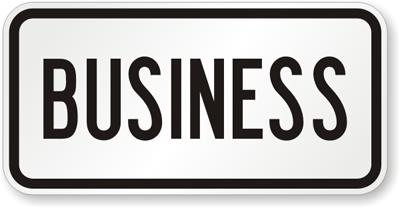| Business Sign X (Photo credits: www.roadtrafficsigns.com) |
Understanding the real value of corporate strategy and the head office.
strategy+business magazine:by Ken Favaro
Senior executives seeking to gauge the effectiveness of their company’s corporate strategy might look at any number of factors: the company’s shareholder returns, its growth rate, its market share, or its price-to-earnings multiple. ... In fact, they might lead executives to precisely the wrong conclusions.
The one true measure of a corporate strategy is the profitability of its head office. ... Of course, in strict accounting terms, corporate headquarters is a cost center because it has no revenues. ... In fact, a profitable corporate center is both literally and figuratively at the center of corporate profit itself.
Corporate Center Profitability
We define corporate center profitability as a company’s attributable performance delta—that is, the difference in financial performance that is attributable to the activities of the corporate center—less the costs of the center itself (see exhibit). By this definition, when the corporate center is profitable, the company is truly worth more than the sum of its parts ..., because the company’s business units (BUs) are outperforming ... in their markets. On the other hand, a company that has an unprofitable corporate center is sending a sure signal that it’s adding no real value to the individual BU strategies..., or worse, it’s a true hindrance to each BU being able to win in its own markets ... .
Research indicates that the performance delta is positive for 45 percent of all companies and negative for the rest. ... When your company’s performance delta is negative, neither your businesses nor your shareholders see much point in having a head office!
Drivers of Corporate Center Profitability
| Corporate headquarters v2 (Photo credit: Wikipedia) |
First, profitable corporate centers sparingly use centralized services such as receivables, payables, financial reporting, payroll, IT, legal, HR, R&D, manufacturing, sourcing, and sales. They know that centralization does not come free—it can slow responsiveness, increase bureaucracy, uncouple costs from the revenues they support, and dilute accountability for top- and bottom-line results—and they know that there are diminishing returns to scale economies. ...
A second key function is capital allocation. The corporate center adds value only if it can do a better job of allocating capital than the “invisible hand” of a vast, liquid, and ruthless capital market. A profitable corporate center does just that by attaining and using its inside knowledge, its ability to actively engage with the business units, its experience with the businesses that make up the company’s portfolio, and a highly disciplined process for funding business units. In these cases, businesses perform better than their peers because they have corporate leaders who are knowledgeable, informed, engaged, experienced, disciplined, and enterprising investors. Unprofitable corporate centers tend to think of capital allocation as rationing rather than investing. ... It is common to see 80 percent of a company’s value creation coming from only 20 percent of its capital base. This is usually the work of corporate doing more harm than good in substituting for the capital markets.
Developing and deploying human capital is corporate’s third key function. Profitable corporate centers use the full breadth of the company’s business portfolio to offer a variety of flexible and rich career paths that will attract and develop people who can make a real difference to the BUs. ... They actively match the company’s strongest talent to its most important priorities, whether these are specific to particular businesses, span multiple businesses, or transcend them. Deadweight corporate headquarters facilitate inbreeding, cultural silos, and hoarding of talent within units. They do worse than what the talent markets do on their own, and they often do it with an enormous and costly corporate HR function. Sooner or later they are forced to go outside the company and pay a premium for the business talent they need.
Business unit governance processes are a fourth key function of corporate headquarters. ... But profitable corporate centers ... work hard to shield the BUs from the worst of short-term behavior—be it from customers, employees, or, especially, shareholders—while also holding their feet to the fire when it comes to producing results. They challenge and help shape the strategies that underpin the BUs’ plans, rather than just sit back and wait until those plans are submitted for corporate’s review and approval. ... They continually ask themselves, “How can we ensure that we are governing the BUs in ways that enable them to outperform in their markets?” ...
Unprofitable headquarters have a completely different attitude. They tend to ask, “How can the BUs help us do our job in running the company?” Thus, they tend to think of their governance role primarily as one of control and compliance rather than as one of adding value. In fact, in our experience, they are more likely to suck the life out of the BUs.
Perhaps the most valuable—and difficult—of all functions is the fifth: incubating, nurturing, and disproportionately investing in the company’s enterprise capabilities. An enterprise capability is something a company is able to do better than any other company. ... Profitable head offices actively identify capabilities anywhere in their organizations that can benefit all their businesses. They stay on alert for acquisitions that would enhance their businesses’ most important capabilities. They organize centers of excellence to nurture certain essential capabilities. They manage costs and capital to ensure that they are investing more and more effectively in their capabilities than any other company. If done well, this can be the most valuable role a corporate center plays in delivering a positive bottom line to the company.
Finally, profitable corporate centers know that their ability to add value depends greatly on the nature and complexity of the company’s portfolio shape. ... Companies with profitable corporate centers tend to be made up of businesses that draw on the same few essential capabilities. This coherence in the company’s portfolio makes it easier to add value through the other five functions.
Good vs. Bad Corporate Centers
| Headquarters (Photo credit: Miroslav Petrasko (blog.hdrshooter.net)) |
Profitable ones, on the other hand, tend to invest heavily in effective internal governance and enterprise capabilities, and then fill their portfolios with businesses that gain the most from their specific governance skills and enterprise capabilities. ... Berkshire Hathaway ... famously has a bare-bones corporate headquarters, with no centralized services, no corporate HR department, and no sharing of enterprise capabilities across its vast, diverse portfolio of businesses. Yet by and large, those businesses consistently outperform in their markets. ... Berkshire oversees a mix of highly capital-intensive businesses (such as trains, utilities, and retail) and substantially cash-generative businesses (such as insurance and reinsurance)—both of which benefit greatly from Berkshire’s undeniable investment prowess. It may not be big, but Berkshire’s corporate center is highly profitable.
Corporate center profitability is the key gauge of whether a company is an accelerator, hindrance, or nonfactor in how well its businesses are able to compete and perform in their respective markets; it is the acid test of whether corporate is truly adding value in excess of its costs; and it is the true measure of a company’s corporate strategy. Every strategist should know what it is and how to achieve it.
AUTHOR PROFILE:
Ken Favaro is a senior partner with Booz & Company based in New York and global head of the firm’s enterprise strategy practice.'via Blog this'















No comments:
Post a Comment